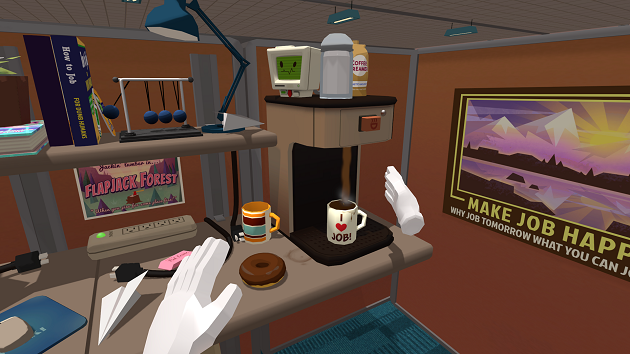Earlier this year it was revealed that Owlchemy Labs would be making some key changes to the various versions of its upcoming virtual reality (VR) title, Job Simulator. While the experience remains as first seen when using the full capacity of the tracking on the HTC Vive head-mounted display (HMD), it will be altered to accommodate smaller tracking areas and the capabilities of the tracking on both the Oculus Rift and PlayStation VR. Recently, studio CEO Alex Scwartz went more in-depth on these differences, providing some specific examples of how the experience can be switched up without sacrificing gameplay.
Speaking to VRFocus in an interview that will be published later this week, Schwartz noted that one of the main reasons for these changes was not to lose hand-tracking. “So we like to talk about it in the way that, Ikea does space saving designs,” he later explained. “So when you need to– let’s say you have a really big room that you’re going to play Job Simulator with the full Vive. We want to try to use as much of that room as possible. You wouldn’t want to keep them within a very, very small square within that so we try to have a large sized design. And so we detect ‘Oh, you’re in a large room, let’s go with that layout’. And so that involves setting up the physical items and the interactable items in a way that works for our game.
“And so that’s like, in the kitchen, we have the counter extended and we put the bell with the plate where you’re delivering food and the fridge a certain amount of units away from each other so you’re physically walking around from one, grabbing stuff and traversing and it gets people up and moving.”
He continued, explaining the more constrained options: “And then when you have a more limited space, Devin [Reimor, CTO] talks about, if you have a laundry room and you have a lot of space you would have side-by-side washer/dryers. But the problem if you can programmatically take that down to half. What they do in the real world if they make a vertical, top to bottom set of layouts. And so we by hand rearrange based on the room size to fit with the space that’s afforded there.
“So when we’re doing like a 6-foot wide tracking area we’ll make sure that everything is accessible within that reach of a wingspan plus like a foot to the left and right. So you still have to walk over to one side and walk over to the other but it’s a more constrained space. But we want to have the same experience across all the platforms, just to fit within the usable area.”
For the latest on Job Simulator, keep reading VRFocus.
-END-
The post Job Simulator Dev Explains Platform Differences With Examples appeared first on VRFocus.















